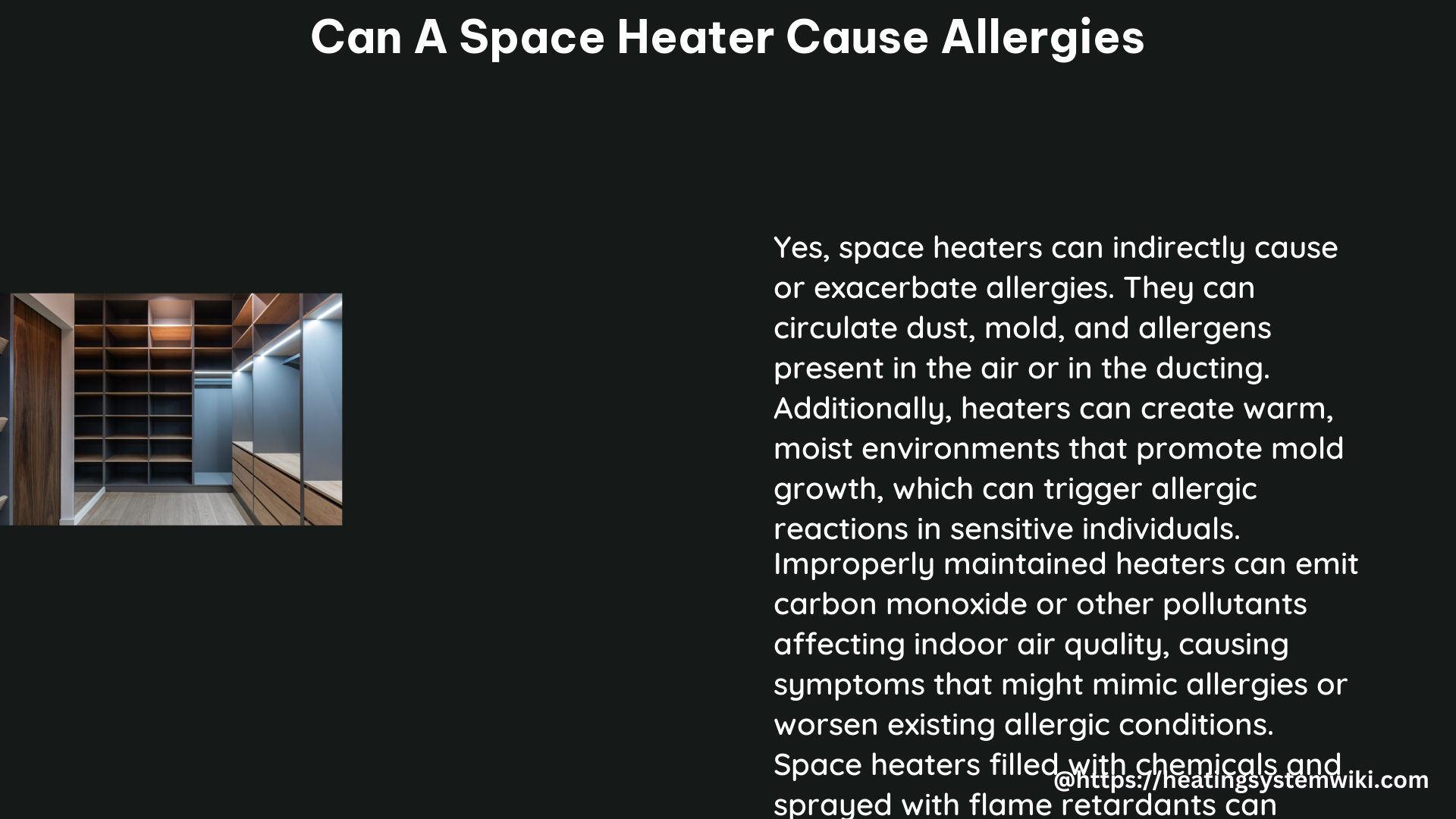Space heaters, while providing warmth and comfort during colder months, can potentially contribute to allergy symptoms by circulating dust, allergens, and other indoor air pollutants. While space heaters do not directly cause allergies, they can exacerbate existing allergy conditions through factors such as dry air, dust and allergen circulation, mold growth, and potential carbon monoxide or indoor air quality issues. Understanding the technical specifications and implementing DIY measures can help mitigate the impact of space heaters on allergy sufferers.
Technical Specifications to Consider
When selecting a space heater, it’s crucial to look for models with features that can help minimize allergy symptoms. Here are some key technical specifications to consider:
- Filtration System:
- Look for space heaters equipped with built-in air filters, preferably HEPA (High-Efficiency Particulate Air) filters.
- HEPA filters are designed to remove up to 99.97% of airborne particles as small as 0.3 microns, including dust, pollen, and other allergens.
-
Some advanced models may feature multi-stage filtration systems, combining HEPA filters with activated carbon filters to capture a wider range of pollutants.
-
Fan Speed Control:
- Choose a space heater with adjustable fan speeds, allowing you to control the air circulation and minimize the spread of dust and allergens.
- Higher fan speeds can help distribute warm air more effectively, but they may also increase the circulation of airborne particles.
-
Adjustable fan speeds enable you to find the right balance between heating efficiency and allergen control.
-
Thermostat Functionality:
- Opt for a space heater with a programmable thermostat, which can help maintain a consistent and comfortable temperature.
- Consistent temperature regulation can prevent the air from becoming overly dry, which can exacerbate allergy symptoms.
-
Some advanced models may even feature humidity sensors and automatic humidity control to maintain optimal indoor air quality.
-
Timer and Automatic Shut-Off:
- Look for a space heater with a built-in timer function, which can help manage the usage and prevent overheating.
-
Automatic shut-off features, such as tip-over protection and overheat protection, can further enhance safety and reduce the risk of potential indoor air quality issues.
-
Safety Features:
- Ensure the space heater has robust safety features, including tip-over protection, overheat protection, and automatic shut-off functions.
- These features help prevent accidents and mitigate the risk of fire hazards or carbon monoxide buildup, which can negatively impact indoor air quality.
By considering these technical specifications, you can select a space heater that is better equipped to minimize the impact on allergy symptoms and maintain a healthier indoor environment.
DIY Measures to Reduce Allergy Symptoms

In addition to selecting a space heater with the right features, there are several DIY measures you can take to further minimize the impact of space heaters on allergy symptoms:
- Regular Cleaning:
- Regularly clean the space heater, including its surfaces, grilles, and internal components, to remove accumulated dust and allergens.
- Use a microfiber cloth or a soft-bristled brush to gently wipe down the heater, ensuring no dust or debris is left behind.
-
For more thorough cleaning, refer to the manufacturer’s instructions, which may recommend disassembling the unit for a deeper clean.
-
Proper Maintenance:
- Follow the manufacturer’s guidelines for maintaining the space heater, including regular filter replacements.
- Replace air filters as recommended, typically every 3-6 months, to ensure optimal filtration performance.
-
Neglecting filter maintenance can lead to a buildup of dust and allergens, which can then be circulated throughout the room.
-
Ventilation and Air Circulation:
- Ensure proper ventilation in the room where the space heater is used, either by opening windows or using a fan to promote air circulation.
-
Adequate ventilation can help disperse any particles that may be disturbed or stirred up by the space heater’s operation.
-
Humidity Control:
- Use a humidifier or dehumidifier, depending on your specific needs, to maintain optimal humidity levels in the room.
- Dry air can irritate nasal passages and exacerbate allergy symptoms, while excessive humidity can promote mold growth.
-
Aim for a relative humidity level between 30-50% for the most comfortable and allergy-friendly environment.
-
Allergen Reduction:
- Regularly clean, dust, and vacuum the room where the space heater is used to reduce the overall amount of dust and allergens present.
- This helps minimize the number of particles that can be stirred up and circulated by the space heater’s operation.
- Consider using a vacuum cleaner with a HEPA filter to capture smaller allergens more effectively.
By implementing these DIY measures, you can help mitigate the potential impact of space heaters on allergy symptoms and maintain a healthier indoor environment.
Conclusion
Space heaters, while providing warmth and comfort, can contribute to allergy symptoms by circulating dust, allergens, and other indoor air pollutants. However, by understanding the technical specifications to look for and implementing DIY measures, allergy sufferers can minimize the impact of space heaters on their health. By selecting a space heater with features like HEPA filtration, adjustable fan speeds, and safety controls, as well as regularly cleaning and maintaining the unit, you can create a more allergy-friendly environment and enjoy the benefits of supplemental heating without exacerbating your allergy symptoms.
